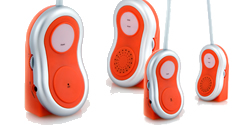
07 Jul Baby Monitors affect your sleep
DID YOU KNOW
Digital (DECT) baby monitors are of particular concern because of their close proximity to the baby and the fact that they use the same frequency as mobile and cordless phones!
For years I observed babies and children with sleep disturbances when a baby monitor was in their room and frequently found the radiation emitted from the monitor was relatively high compared to most other Wi-Fi enabled devices used in a home. I subsequently embarked on testing my hypothesis and undertook the first world study to test the impact of a Wi-Fi enabled device (baby monitor) on sleep in healthy adults under real world conditions (sounds easy however the process took me 5 years by the time I got ethics approval @ RMIT, registered the study, and published the findings in a high end journal). My findings: one third of the adults developed clinical insomnia within 7 nights of sleeping with a baby monitor in the room. Shocking isnt it! You can read the paper HERE.
Here’s a summary of the key findings of my study (Frontiers in Public Health Journal, Does Radiofrequency radiation impact sleep? A double-blind, randomised, placebo-controlled crossover pilot study, October 2024):
- Sleep quality: participants (adults) reported significantly worse sleep quality when exposed to the active baby monitor for 7 consecutive nights compared to the inactive (sham) monitor according using the Pittsburgh Insomnia Rating Scale questionnaire.
- Insomnia risk: 27% of participants scored high enough on the sleep questionnaire to be at risk for clinical insomnia when exposed to the active monitor.
-
Brain activity during sleep: the study found significant increases in brain wave activity (theta, beta, and gamma waves) during Non-REM sleep when participants were exposed to the active monitor.
-
Heart rate variability was not impacted HOWEVER it would have reached statistical significance had we had more participants in the study.
-
Individual differences: the negative effects on sleep quality were most pronounced in women in their 40s and 50s, suggesting some people may be more sensitive to this type of radiation
Testing
Baby monitors may emit radiofrequencies (wifi component) and/or magnetic fields if they are fitted with a cheap inefficient transformer. Talk back models, camera and video baby monitors often continuously emit pulsing radiation even when noise is not being made. Testing baby monitors requires high frequency meters to measure radiofrequency and gauss meter to measure the magnetic field.
Solutions
I would avoid using these monitors, unless your baby has a medical condition that requires monitoring or at risk of Sudden Infant Death Syndrome. In that case consider:
- hard wired CCTV camera is better (no Wi-Fi component)
- if you must use a baby monitor, keep it at least 2 metres away from the cot
- set it to voice activation mode to prevent it transmitting continuously
- choose a cordless analogue model (they only have 2 to 4 channels) as they use a lower frequency than digital models
- avoid using the talk back models as both units continuously emit pulsing radiation even when there is no noise
- avoid camera and video baby monitors as they require a higher power output.
